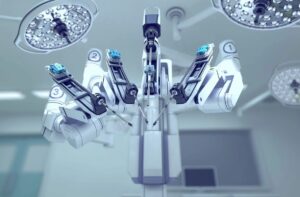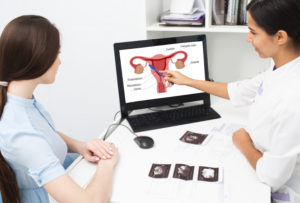By Iris Farrou
31 Jul, 2023
Da Vinci Robotic Surgery, Health Conditions and Pregnancy, Hysterectomy, Menopause, Peri-Menopause, Peri-Menopause, Procedures, Queer Health, Reproductive health, Robot Hysterectomy, WNY Ob-Gyn News, Women's Health
3D imaging, abnormal vaginal bleeding, Cancer Treatment, cervical, cervix, endometriosis, faster recovery, fibroids, Laparoscopic Surgery, minimally invasive surgery, Ovarian, ovaries, pelvic pain, Precancer, Robot Assisted Hysterectomy, Robot Hysterectomy, uterine, uterine prolapse, uterus
 What is it?
What is it?
You may have heard of a traditional hysterectomy, which refers to the surgical procedure to remove the uterus (hysteros) from the body. In this case, the procedure is done with a large incision and requires longer recovery time. Nowadays, doctors can use robotic technology to their advantage–and to the advantage of the patients–to perform certain procedures, hysterectomy being one of them. In robotic hysterectomy, your doctor uses the technology to make small incisions of 1-2cm and fully controls the robotic arms with a controller while looking at a 3D magnified image of the area of surgery on their screen.
How does it work?
Robotic hysterectomy is a type of laparoscopic surgery: it is less invasive than traditional surgery, and patients experience much less pain, faster recovery, and less blood loss than open abdominal hysterectomy. Your doctor makes small incisions on your abdomen, and then inserts a laparoscope and other surgical instruments through the incisions. The laparoscope is a very thin tube with light and a camera at the end, thus projecting the surgery on a high-definition and magnified screen; this allows your surgeon to be aware of a lot more details during the surgery, as well as possible problems, than the human eye itself since the image is magnified up to 15 times.
The instruments used during robotic hysterectomy, particularly the technology of the daVinci surgical system, mimic the movement of human hands but with a lot more dexterity, precision, and flexibility. Your surgeon has full control over the instruments at all times, and they would be in the operating room just a few feet away from you. As opposed to traditional surgery where the surgeon would be standing over you for long periods of time, robotic hysterectomy allows your surgeon to utilize the constant steadiness of the robot arms to operate from angles and positions that would be typically hard to reach. Keep in mind that the robotic arms are more precise than natural hand movements, and they will not get tired during the surgery.
Who needs it?
Hysterectomies may be suggested to treat conditions like cancer or precancer of the uterus, cervix, and ovaries, uterine prolapse, endometriosis, uterine fibroids, pelvic pain, and abnormal vaginal bleeding.
Robotic hysterectomy is one of the methods surgeons can use to remove the uterus from the body, and though less invasive and more precise, surgeons decide on a case by case basis whether robotic hysterectomy is an appropriate option for their patients. Robot assisted procedures can be especially helpful if you have a complex surgical case, such as scar tissue that binds surrounding organs together and would need more precision during surgery.
What happens after it?
Like with any surgery, there will be a recovery period. Patients who have had robotic hysterectomies report that they heal faster and experience less pain; we need to remember that every body is different, and that people recover at different rates. After a robotic hysterectomy, you may be expected to stay the night at the hospital, and you may experience vaginal bleeding for a few days or weeks after your surgery. Full recovery can take 3-4 weeks, and vaginal intercourse should be avoided for at least 6 weeks after the surgery. If you are concerned about any symptoms or adverse reactions, reach out to your doctor and immediately seek professional assistance.
https://my.clevelandclinic.org/health/treatments/21057-robotic-assisted-hysterectomy
https://www.mayoclinic.org/tests-procedures/robotic-hysterectomy/about/pac-20384544
More

Even though they are not very common, some women are born with an abnormal uterus, including a defect in the size, shape, or structure of the uterus. The two most common types are called heart-shaped uterus and tipped uterus.
What is commonly referred to as a heart-shaped uterus is actually a “bicornuate uterus.” It occurs when the fallopian tubes come together on top of the main uterine cavity and form a shape that resembles a heart. Romantic as this may sound, uterine irregularities may cause complications during pregnancy.
A tipped uterus (officially referred to as a retroverted uterus) is a type of uterus that tilts in a backward position at the cervix instead of forward. A tipped uterus can either be a variation of pelvic anatomy by birth, or it can develop as women mature. Less romantic-sounding than the heart-shaped uterus, a tipped uterus may also be the result of pelvic scarring or adhesions.
Symptoms
Neither condition has particularly noticeable symptoms, and both are usually determined when women get either a pelvic exam or an ultrasound. Common symptoms of an abnormal uterus include the following:
| Heart-Shaped Uterus |
Tipped Uterus |
| Irregular vaginal bleeding |
Lower back pain during intercourse |
| Repeated miscarriages |
Trouble inserting tampons |
| Painful periods and abdominal discomfort |
Increased urinary frequency and UTIs |
| Pain during intercourse |
Protrusion of the lower abdomen |
Keep in mind that in the case of a heart-shaped uterus the symptoms may not feel out of the ordinary, as you have most likely had it your whole life.
Causes
Women with heart-shaped uteri are born this way, so the cause is simply the way the uterine cavity and fallopian tubes are shaped. However, a tipped uterus is not always a birth defect and its possible underlying causes warrant attention:
- Endometriosis: endometrial scar tissue or adhesions may cause the uterus to stick in a backward position.
- Fibroids: uterine fibroids can cause the uterus to tilt backward.
- Pelvic Inflammatory Disease (PID): if left untreated, PID can cause scarring that has a similar effect to endometriosis.
- History of pelvic surgery or prior pregnancy: in both, or either, case the ligaments that hold the uterus in place can become stretched/ scarred and cause the uterus to tilt backward.
Pregnancy and Fertility
In the case of a heart-shaped uterus, the chances of conceiving do not become less, nor is your fertility affected. It has, however, been suggested that this uterine shape is more common in women who are infertile.
A heart-shaped uterus increases the chances of a miscarriage in the later stages of a pregnancy, or an early delivery of the baby. These cases are connected to either reduced uterine capacity or irregular uterine contractions. Additionally, babies born to mothers with a heart-shaped uterus are four times more likely to develop birth defects. It is also more likely that you will have to give birth via a C-section.
Though a tipped uterus does not affect a woman’s ability to conceive, it is often connected to other conditions that may lead to fertility issues. These include endometriosis, pelvic inflammatory disease (PID) and fibroids. When necessary, infertility treatments such as intrauterine insemination (IUI) or in vitro fertilization (IVF) assist women with these diagnoses to achieve pregnancy.
More
 What is it?
What is it?
